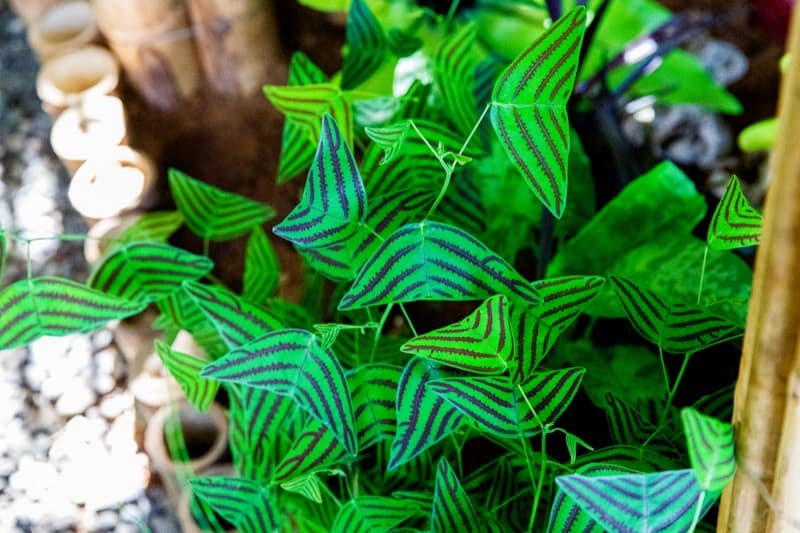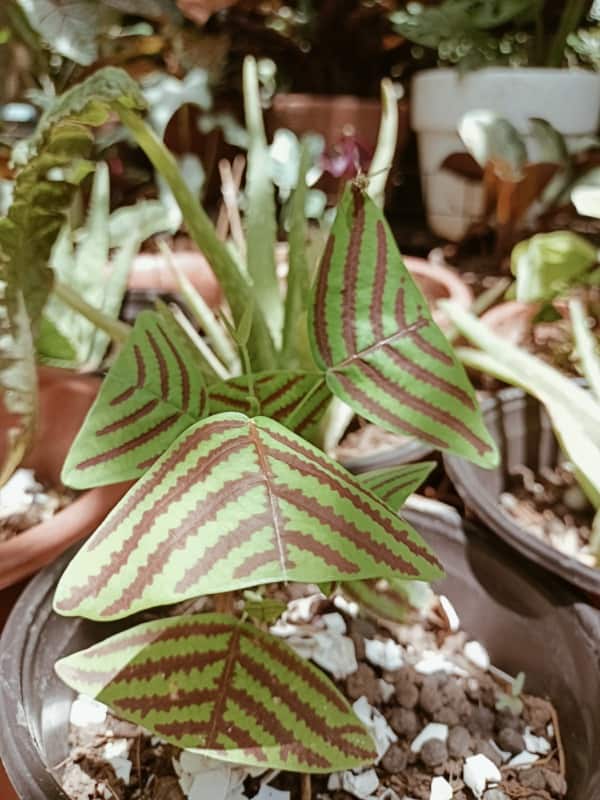Do you love butterflies? Then you should definitely check out this houseplant care guide for the Christia Obcordata, also known as the Swallowtail Butterfly Plant or Butterly Wing Plant.
The Christia obcordata plant resembles beautiful butterflies in your yard and garden because their triangular foliage look like butterfly wings.
In this care guide, I’ll share with you everything you need to know about caring for Christia obcordata plants. It contains everything you need to know to keep your butterfly plants healthy and happy.
Christia Obcordata Overview
Christia obcordata is a beautiful and unique plant that will certainly grab anyone’s attention.
The common name of the plant comes from its triangular foliage with green and burgundy stripes. It is similar to the veins in a bird’s feathers, such as the Swallowtail bird. The leaf shape is similar to that of a butterfly’s wing.
The Swallowtail Plant is great for planting in pots and hanging baskets. It adds a nice splashy pop of color and contrast to planted containers. Brightens up your windows and home indoors.
I personally like planting the Christia obcordata in decorative pots and hanging baskets. cascading effect of its foliage makes it perfect for vertical garden setups, and some even incorporate fairy lights for a magical ambiance.
Here are some quick facts about the plant:
- Common Names: Swallowtail Plant, Butterfly Plant, Butterfly Wing Plant
- Botanical Names: Christia Obcordata; Hedysarum obcordatum Poir.; Lourea obcordata (Poir.) Desv.
- Plant Type: Tropical Plant, Bush or Shrub, Herbaceous Perennial Plant
- Mature Size/Height: 18-24 in. tall, 18-24 in. wide
- Sun Exposure: Bright, indirect light; Partial Shade
- Temperature and Humidity: Warm temperatures between 65-80°F (18-27°C) with high humidity levels
- Soil Type: Moist, well-draining, rich
- Soil pH: 7.0 to 8.0 (alkaline)
- Bloom Season: Spring, Summer
- Native Areas: Southeast Asia including India, Thailand, Taiwan, Australia, and Laos
- Toxicity: Mildly toxic to pets and humans

Christia Obcordata Care Guide
Here is a step-by-step guide on how to take good care of Christia Obcordatas. This includes information on when to water them, fertilizing them, growing them indoors, and more.
Christia Obcordata Seeds
The seeds of Christia Obcordata are your gateway to cultivating this ornamental gem. They germinate best in warm, well-lit conditions. Once sprouted, the plant can thrive both indoors and outdoors, given the right care.
Inside, they brighten up living spaces, while outdoors, they can transform garden areas into vibrant displays of nature’s artistry.
Their adaptability makes them a delightful choice for gardening enthusiasts, offering a slice of the tropics wherever they are nurtured.
I will add here that it’s not always easy to germinate Christia obcordata seeds. I’ve also had friends living in warm temperatures who have success rates of three plants out of 15 seeds and two plants out of 14.
Soil for Christia Obcordata
The Christia Obcordanata thrives in moist, well draining soils. Soils with high organic matter content are ideal. Using peat moss will help increase moisture retention in the soil.
If you have clay based soil, then it is not beneficial to add some sandy soil to the mix because it won’t improve drainage.
To ensure that the plant has enough room to grow, existing soil needs to be thoroughly broken and worked up so that the plant can establish itself quickly.
Adding organic matter like peat moss or compost to the soil can help improve its quality. This is also the time when you can add fertilizer to help supply the soil with nutrients.
Many experienced gardeners suggest a mix of potting soil, perlite, and a bit of sand to achieve the perfect texture. Remembering to do a “finger test” (inserting a finger an inch into the soil to check for moisture) is a commonly shared trick to avoid overwatering.
Light for Christia Obcordata
You can grow Christia Obcordata under bright, indirect sunlight. However, if you live in an area where there is lots of direct sun exposure, then you may want to move your Christia Obcordata to a shadier spot.
Bright, indirect sunlight has been the key for me growing the Christia Obcordata. If you find it difficult to do because you get a lot of direct sunlight in your south-facing windows, I suggest trying sheer curtains or a light diffuser. It’s important to do that to prevent leaf burn.
Just make sure they receive enough light so that they don’t become leggy.
Water for Christia Obcordata
This plant needs lots of water to grow properly. Watering regularly is essential. Focus on watering the roots and avoid overwatering.
Make sure the pot has good drainage holes, so the excess water will drain out. Otherwise, standing water will lead to root rot and harm the plant.
You can tell if a plant needs more water by looking at the soil around the roots of the plant. If the first few layers of soil are dry, it’s time to water the plant.
Note to not get any water on the leaves of the plant as that can lead to mildew and mold.
Temperature and Humidity for Christia Obcordata
This plant thrives in warm temperatures between 65-80°F (18-27°C). It also appreciates high humidity levels, so misting the leaves or using a humidifier can be beneficial.
If you live in a warm climate, then you can grow Christia Obccordata outdoors year round. For those in cooler areas, bring the plant inside during frosty months. Place it in a room with consistent temperature, away from cold drafts or heaters.
Ensure that the minimum temperature range is 40° – 50°F (4° – 10°C) wherever you place them.
It will grow best in USDA zones 11 and 12.
Fertilizer for Christia Obcordata
Using a balanced fertilizer will help the butterfly plant grow healthily. You can use different kinds of fertilizers: liquid, organic, granular slow release, or chemical fertilizers.
Granules are spread around a plant to help it bloom. Liquid fertilizers come in bottles or cans. Organic fertilizers are made from natural sources such as composted manure. Synthetic fertilizers use chemical compounds instead of natural ingredients.
Be careful when applying fertilizer. Too much fertilizer can damage the swallowtail plants and cause them to wilt. Follow instructions when using fertilizer to ensure you apply the correct amount.

Propagating the Christia Obcordata
Propagating the Christia obcordata from seed is the best and most popular method of growing the plant.
It’s hard to find the plant commercially, so propagation through cuttings is difficult. There also hasn’t been enough consistent success from horticulturists when propagating from cuttings.
To propagate with seeds:
- First make sure that you have enough space to grow your Christia obcordata plant.
- Take some seeds and put them into a paper bag or container.
- Put the container in a dark and cool place, such as a drawer or cupboard.
- Keep the container away from heat sources such as radiators or heating vents.
- After three weeks, check if any of the seeds have sprouted.
- If seeds have sprouted, then gently remove them from the container and plant them in soil.
- You should be able to see roots emerging after two months.
- Once the roots are well established, you can transplant the plant outdoors.
If you are purchasing seeds online, always purchase from reputable sellers to ensure authenticity. These are popular plants, so there are chances for fake seeds.
Potting and Repotting the Christia Obcordata
Put the young plant in the ground, and then carefully fill in the space around the roots.
Make sure the soil around the planted butterfly bush is flat and even.
The new planting should be watered regularly to keep the soil moist.
Pruning the Christia Obcordata
Prune any leggy or unhealthy growth to maintain a compact and bushy shape. Regularly remove any yellow or dead leaves to keep the plant healthy.
Prune plants regularly to keep them at their desired size and shape. Pinching plants to encourage them to grow back thickly stimulates dense, bushy growth and encourages more flowers to bloom.
To keep them looking healthy and prevent seed formation that depletes the plant’s energy at its expense, remove old flowers and leaves. These plants are often grown for their beautiful leaves, such as the dusty miller, coleus, and flowering kale.
They don’t produce very showy flowers and any buds should be cut off to keep the foliage looking great.
Christia Obcordata Pests and Diseases
Like many houseplants, the Christia Obcordata can occasionally be susceptible to a range of pests and diseases. Watch out for common houseplant pests like aphids, mealybugs, and spider mites. Treat any infestations promptly with insecticidal soap or neem oil.
Here’s what to watch out for and how to handle them:
- Aphids: These small, soft-bodied insects can be green, yellow, black, brown, or red. They suck the sap from plants, leading to curled or yellowed leaves. If you notice a sticky substance on your plant or see these tiny pests on new growth, you might have an aphid issue.
Solution: Spray your plant with a strong jet of water to knock the aphids off. For more persistent infestations, apply insecticidal soap or neem oil. - Mealybugs: Recognizable by their white, cottony appearance, mealybugs feed on plant juices. They’re often found in clusters in leaf axils or other sheltered spots.
Solution: Dab individual bugs with a cotton swab dipped in alcohol. For larger infestations, spray with insecticidal soap or neem oil. - Spider Mites: These are tiny arachnids and are often hard to see with the naked eye. You might notice them as fine webs on the plant or by the speckled and yellowed leaves they leave in their wake.
Solution: Increase humidity around the plant, as spider mites thrive in dry conditions. You can also wash your plant with a strong stream of water. If these methods don’t work, turn to insecticidal soap or neem oil.
Regularly inspect your Christia Obcordata for any signs of these pests. Early detection is key to preventing significant damage.
It’s also essential to ensure your plant is not under stress, as stressed plants are more vulnerable to pests and diseases. Keep it in the optimal conditions mentioned in this guide, and it’ll be better equipped to fend off any unwanted visitors.
Christia Obcordata Ornamental Use and Companion Plants
The Christia Obcordata, with its butterfly-like foliage, serves as a stunning ornamental piece, brightening indoor spaces or gardens. Its vibrant leaves create a visual allure, especially when planted in pots or hanging baskets.
In my own journey of growing and nurturing the plant, a fascinating discovery I made was the plant’s unique ability to change colors across different seasons – from spring to fall.
This wasn’t something I initially expected, and I must admit, I was taken aback by the sheer beauty and the absence of prominent stripes on its leaves.
Companion Plants:
- Coleus: Known for its colorful foliage, complements the butterfly plant well.
- Cladium: Adds a textural contrast with its large, grass-like leaves.
- Sweet Potato Vine: With its cascading vines and heart-shaped leaves, it pairs beautifully, creating a lush ensemble.
Pairing Christia Obcordata with these plants not only enhances its beauty but also creates a visually appealing garden space, enriching your horticultural experience.
Medicinal Qualities of Christia Obcordata
Christia Obcordata has a rich history of medicinal use, particularly in certain Asian countries:
- Urinary Blockage Relief: It’s known to aid in relieving urinary blockages.
- Treatment for Nephritis: Acute and chronic nephritis are also conditions it’s believed to alleviate.
The plant’s medicinal benefits offer a unique appeal alongside its ornamental charm, making it a valuable addition to your garden or home. Though its medicinal uses are revered in traditional practices, it’s advisable to consult with a healthcare professional before utilizing it for any medicinal purposes.
Is the Christia Obcordata Toxic to Cats?
The Christia Obcordata (swallowtail plant or butterfly wing plant) is not toxic to cats, dogs, and humans. However, similar to other non-toxic houseplants, if your pets eat large amounts of the leaves and plant parts, that could lead to an upset stomach.
Christia Obcordata Final Thoughts
The swallow tail plants are easy to care for and maintain. They require regular watering and feeding, but these tasks aren’t difficult. The main thing you need to remember is not to overwater your plants.
Here are some other houseplants you might be interested in:
Christia Obcordata FAQs
Is Christia an Obcordata?
The Obcordata is actually in the Christia genus family. The Christia obcordata (Poir.) is also a flowering leguminous plant that’s in the Fabaceae family. It’s the same family of legumes like beans and peas.
Like the Obcordata, there are at least ten other species in the Christiaceae family that are prostrate herbaceous perennial plants.
How Do You Germinate Christia Obcordata?
If you want to start your own Christia obcordatas, you’ll need to buy some seeds first. These will germinate easily once sown in warm, bright light.
Sow seeds directly onto the surface of dampened potting mix, cover with plastic wrap, and leave in a warm room until seedlings start to appear. Lift the plastic daily to give it some oxygen and ventilation.
When you’re ready to transplant your seedlings outside, use only fresh potting mix and place them into larger pots filled with fresh potting mix. Water thoroughly before placing the pots in a warm and humid location.
Is the Butterfly Plant an Indoor Plant?
Yes, the butterfly plant is one of the best indoor houseplants because it grows quickly and doesn’t require much attention. This makes it perfect for beginners who just want to get started growing their own houseplants. Provide them a warm and humid place indoors and they’ll grow well.


This is all amazing information. I did want to let you know. I was able to propagate this from a cutting. And it’s thriving. 😊
That’s awesome! How difficult was it to propagate the Christia obcordata with cuttings for you? What’s the environment like where you live? Because that’s always a big part of it in my experience.